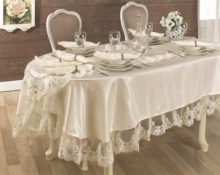 Tablecloths come in a variety of shapes - round, square or rectangular. They can be intended for the kitchen or living room, everyday or festive.
Tablecloths come in a variety of shapes - round, square or rectangular. They can be intended for the kitchen or living room, everyday or festive.
If you like to cover tables with tablecloths, then most likely you will be interested in this article. After all, today we will tell you how to properly hem them with your own hands.
The edge of the product can be hemmed in different ways: hemmed with an open or closed cut, trimmed with lace or ribbon. In any case, the hemmed product looks much better and will last longer.
Processing tablecloth corners

To work we will need:
- tablecloth or linen;
- scissors, needle, thread, pins;
- cardboard paper and a simple pencil;
- iron and sewing machine.
First, we measure the table so that the tablecloth fits perfectly. Keep in mind that a few cm will be spent on hemming + the tablecloth should hang down.
First you need to make strips 5 cm wide from thick cardboard. At least 20 cm long. This will be the pattern along which the edge of the tablecloth will be ironed.
IMPORTANT! In order for the corners to be neat, you need to carefully iron the edges of the tablecloth.
Of course, this takes a lot of time, but the result is worth it.
We put cardboard over this, fold it over and iron it. Try to keep everything perfectly even. Instead of ironing the edges, you can baste using the needle forward method. Removing such a basting is very simple - you just need to pull the knot of thread.
After this, we shift the cardboard and iron it again. With this overview we will get a weighted edge.
We iron the corners so that they do not unfold. Already at this stage the product turns out to be much more attractive.
After ironing, pin the edges using pins. During stitching we will gradually remove them.
How to hem the edges of a tablecloth

After this, we proceed directly to hemming the edges.
On the reverse side, use a simple pencil to mark where exactly the stitching should be. After that we sew. It is very important that the stitching lies evenly. If you are just learning to sew on a machine, don’t rush. It is very important that the corners are even and match perfectly. It’s better to check all the edges several times than to rip everything apart later and leave marks from the stitching.
After stitching, we remove all excess. When you stitch, remember to remove the pins as you go. Although even if you don’t pull them out in time, nothing bad will happen, but sometimes they can get under the needle and it will break. This happens extremely rarely, but it’s better to be safe than sorry.
You can pull out the corner using a needle or pin. The finishing of the edge of the tablecloth has now come to an end. It took no more than an hour to hem, but the result is worth it.
Useful tips

- An excellent life hack on how to cut fabric for a product evenly. If your scrap is too large and you need to cut a smaller tablecloth, there is a great method. To do this, you need to make a notch in the right place on the canvas and start pulling the thread. We pull out the thread, and in its place there remains a mark, and we begin to cut along it. This method is only good if the material is not skewed, otherwise the weight can only be ruined.
- You can use a needle or pin to turn the corner of the product inside out.
- You can also trim the tablecloth with lace or satin ribbon. First you need to baste the ribbon to the tablecloth, and then attach it using a sewing machine.
- If you don’t know how to sew on a typewriter, then you can process the tablecloth even easier and faster. For this it is necessary You can use hot glue to glue the ribbon to the tablecloth.
- If the material does not crumble, then you don’t have to sheathe it. But if the fabric is very frayed, then there is no way to do without overcasting.
- You can make a beautiful tablecloth from a piece of fabric or even from a curtain.
- You can sew napkins from leftover fabric to make a great set for entertaining.
Now you can decorate your holiday table with a tablecloth made by yourself. Based on step-by-step instructions, this is quite easy to do even for a novice needlewoman.
I wish you creative success!


 0
0





